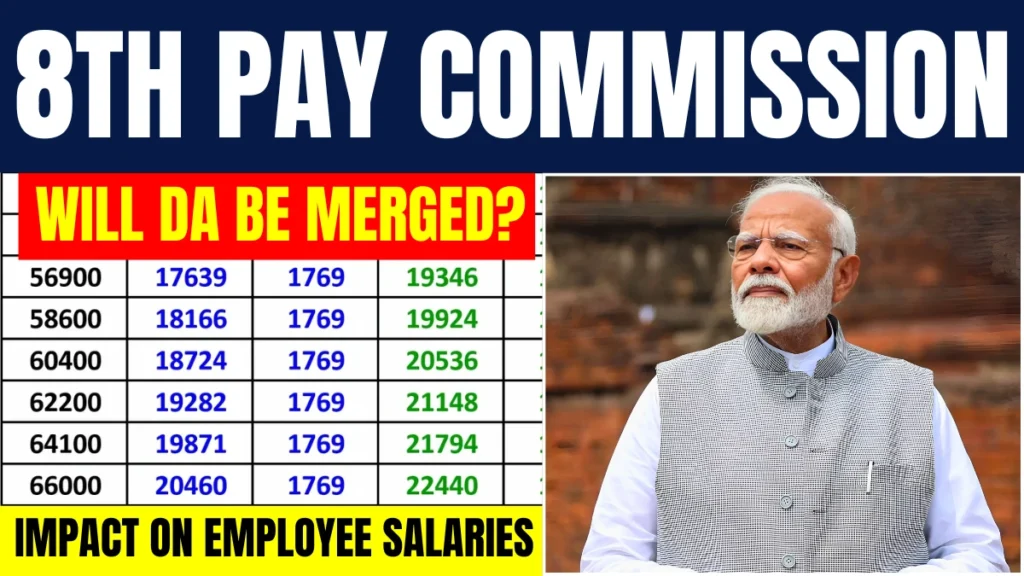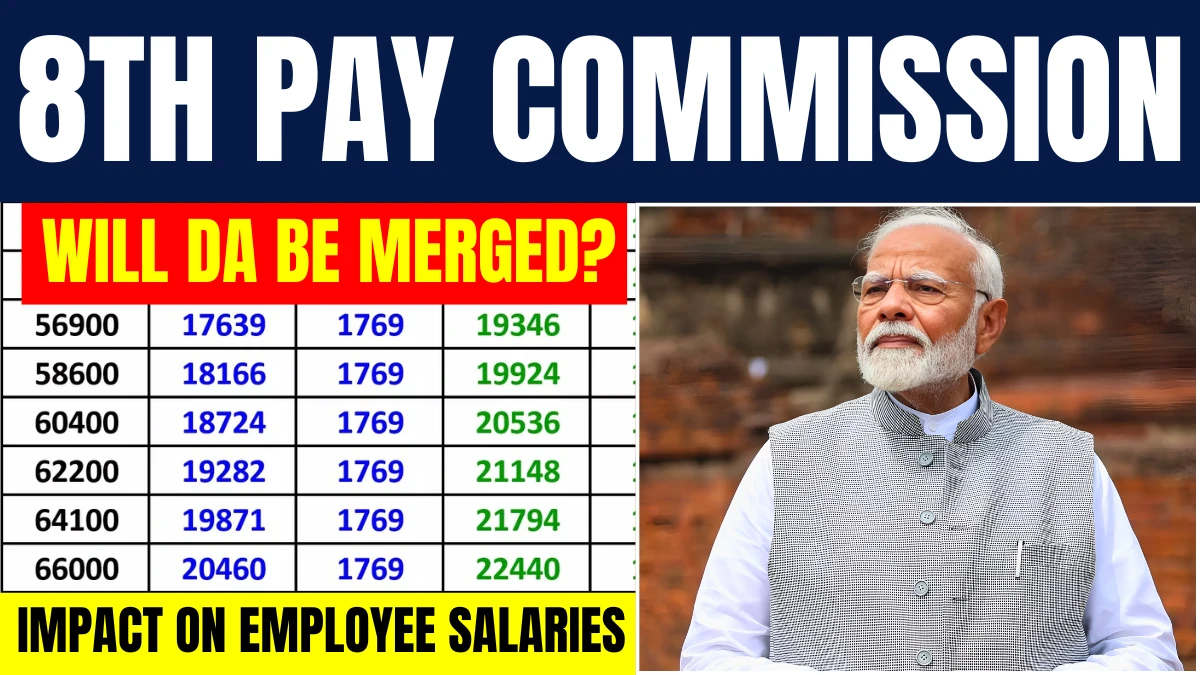8th Pay Commission: The 8th Pay Commission is generating significant buzz, especially regarding the possibility of merging Dearness Allowance (DA) with the basic salary. As India’s economy grows, the cost of living continues to increase, making such discussions highly relevant to government employees and pensioners alike.
This article explores the implications of merging DA with basic pay, the expected impact on employee salaries, and the broader effects on pensions.

What is the 8th Pay Commission?
The Pay Commission is a body set up by the Indian government to revise and recommend salary structures for its employees. The 8th Pay Commission, which is expected to be implemented in the near future, will bring significant changes to the pay scales and allowances for central government employees. The Commission’s recommendations will influence a wide range of sectors, including civil services, military personnel, and pensioners.
Current Salary Structure of Government Employees
Before discussing the potential merging of DA, it’s important to understand the existing salary structure. Currently, government employees receive a basic salary along with several allowances such as House Rent Allowance (HRA), Transport Allowance (TA), and of course, Dearness Allowance (DA). The DA is a percentage of the basic pay and is revised every six months based on the inflation rate. It helps employees cope with rising living costs and inflation.
What is Dearness Allowance (DA)?
DA is a cost-of-living adjustment allowance paid to government employees, pensioners, and workers in the public sector. It is meant to cushion the effect of inflation and rising prices on workers’ real income. The percentage of DA varies according to the Consumer Price Index (CPI), and it is typically revised twice a year, in January and July. The DA is directly proportional to the inflation rate, ensuring that government employees are able to manage the increasing cost of living.
Will DA Be Merged with Basic Pay?
The potential merging of DA with basic pay is one of the most anticipated changes under the 8th Pay Commission. Over the years, there has been consistent demand from employees and unions to merge the DA into the basic pay to ensure that it contributes to pension calculations and improves overall salary packages. The merger would mean that DA no longer remains a separate allowance but becomes part of the base salary.
Why is the DA Merger Being Discussed?
The discussion around merging DA with basic pay has gained traction for several reasons. First, employees argue that the current system of separate DA leads to discrepancies in pension calculations. Since DA is not included in the basic pay when calculating pensions, pensioners do not benefit fully from the allowances they received during their service years. Second, a merger would lead to an increase in employees’ overall salary and pension benefits, making it a more attractive proposition for the workforce.
How Would Merging DA Affect Salaries?
If DA is merged with the basic pay, it would have a direct impact on the salary structure. Since DA is a significant portion of an employee’s total earnings, merging it with basic pay would lead to a substantial increase in take-home pay. Employees could see a rise in their gross salary, which would also increase their allowances such as HRA and TA, as these are calculated based on the basic pay.
Moreover, the increase in basic pay would also mean that employees would contribute more to their provident fund (PF) and other retirement benefits. While this may seem like an added burden, the long-term benefits would be substantial in terms of pension payouts post-retirement.
How Would Merging DA Affect Pensions?
One of the most significant benefits of merging DA with the basic pay is the potential increase in pension benefits. Currently, DA is not included in the basic pay when calculating pensions, meaning that pensioners often receive a smaller monthly payout compared to their active service salary. If DA is merged, the pension would be calculated on a higher base, leading to an increase in monthly pension disbursements.
For example, if an employee’s DA constitutes a large portion of their salary, merging it with the basic pay would mean that pensioners will continue to receive a larger pension, which will help offset the inflationary pressure during their post-retirement years.
Impact on Retired Employees and Pensioners
The merging of DA with the basic pay will benefit not only current employees but also retired government employees and pensioners. A significant portion of pensioners’ income is reliant on their pension, and with inflation constantly eroding its value, the merger would ensure that pensioners’ purchasing power remains protected. It would also reduce the gap between the salaries of active employees and their retired counterparts, bringing them closer in line with one another.
Challenges to the DA Merger Proposal
While merging DA with the basic pay seems to be a logical move, several challenges need to be addressed before it can be implemented. The first challenge is the financial impact on the government’s budget. Merging DA with basic pay would result in a significant increase in the government’s wage bill. This would require the government to allocate additional resources for employee salaries and pensions, which could strain public finances.
Another challenge is the potential resistance from certain sections of the government. Some officials may argue that merging DA with basic pay could lead to a rise in inflation, as higher salaries and pensions may drive up the cost of living. Additionally, some may argue that the current system of separate allowances allows for more flexibility in managing inflation, as DA can be adjusted independently.
Will the 8th Pay Commission Implement the Merger?
It remains to be seen whether the 8th Pay Commission will implement the merging of DA with basic pay. While the proposal has been discussed in various forums and is seen as a priority by many employee unions, the final decision will depend on various factors, including the financial health of the government and its ability to manage the increased expenditure. Employees and pensioners will have to wait for the official recommendations and their subsequent approval by the government.
What Other Changes Are Expected from the 8th Pay Commission?
Apart from the potential merger of DA, the 8th Pay Commission is expected to bring other significant changes to the pay structure. These could include changes in the fitment factor, new allowances, and improvements in pension schemes. The fitment factor, which is used to determine the basic pay for employees, is likely to undergo a revision, leading to higher pay for government workers.
In addition to pay revisions, the Commission might also recommend improvements in healthcare benefits, housing schemes, and work-life balance policies for government employees.
Conclusion
The prospect of merging DA with basic pay under the 8th Pay Commission has raised expectations among government employees and pensioners. If implemented, this change could lead to higher salaries, improved pension benefits, and better overall financial security for retired employees. However, the implementation of such a policy would require careful consideration of the financial impact and the long-term effects on the economy. Until the official recommendations are released, the fate of the DA merger remains uncertain, but it is certainly a development to watch closely in the coming months.
Disclaimer
This article is for informational purposes only and reflects current discussions around the 8th Pay Commission. The recommendations mentioned are speculative and subject to official approval by the government.
